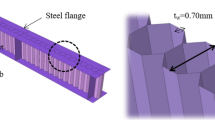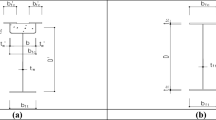Abstract
Plate blocks are commonly used as a structural element in the construction of buildings, bridges, ships and marine utilities, which help to run services such as pipes and tubes beneath the web panel. This study presents a strength analysis of web holes in plate girders subject to point loading by testing and numerical analysis in terms of post-bucking behaviour. The girder measures 120 mm wide for both the sections and 500 and 400 mm depth for plate girder 1 (PG1) and 2 (PG2), respectively. Two specimens of each plate were experienced to determine the strength performance of the plate curvature components. The results of the ANSYS Workbench were used to evaluate the numerical analysis failure mode, including load–deflection curves, strength reliability and analysis and compared the values of the investigational approach on plate girders.
Access provided by Autonomous University of Puebla. Download conference paper PDF
Similar content being viewed by others
Keywords
1 Introduction
Plate girders are currently made by welding three plates together: two flange plates and an I-section to a web fit. Blade curter is a cost-effective solution for broad span beams (over 20 m). The flexural strength of a plate is highest along its circumference. Welded plate girders, the most common form of plate girders, are structural steel members that consist of flange plates welded to a web plate with fillet welds. They are used to support loads at long intervals and to support structural loads that are too large to be supported by rolled steel forms. They are used as transfer ropes in building structures to support columns above areas where there is no large column. Plate ropes can be used to rehabilitate existing building structures that require non-columns and existing columns must be cut below a certain ground level or removed. Plate girders are used as crane support girders in heavy industrial structures with long gaps. The web plates or edge plates are connected as an assembly by appropriate angles. Also, since the plate circumference is expected to carry large loads, horizontal and vertical stiffeners are used in places where concentrated loads are operated to avoid excessive buckling [1]. To increase the moment of resistance, flange plates can be inserted at the flange angles. The bending moment to be resisted is reduced and the plates can be lowered where the plates are not needed [5].
Over the past decades, a majority of researchers have been openly studying steel plate blocks. The strength behaviour of trapezoidal curved corrugated beams with different radii of curvature, web thickness and edge thickness were examined. The result is reduced beam weight without compromising on strength, which can reduce costs by up to 30%. The use of corrugated nets in bridge construction will minimise the need for intermediate diaphragms for cross-load movement [10]. The dynamics of plate cutting buckling are studied using an experimentally validated finite element model. The findings of this analysis suggest that an abbreviated approach to calculating plate post-bucking shear performance is well reflected by an honest representation of shear bucking dynamics and detailed test data, where advanced associations with stress field action formulas are found in many situations [2, 4]. Thin-plate rope web panels are often exposed to a combination of bending, cutting and localised compression edge or patch loading [3]. While contact formulas for the final resistance to the combination of the two in the three types of loading have been suggested and tested by test results, it does not appear that any contact formula has been proposed for the three types of loading relation. Test results for integrated curvature, cut and connection loading are used to validate an integrated formula for the final resistance of thin-plate perimeter web panels [8]. The shear resistance of the transversely stiffened steel I-girders was evaluated and implemented in the bridge design specification [5, 6].
2 Test Specimens
The test specimens consist of two plate ropes 1.5 m long. Although two-blade curters were tested in each series, the girder measures 120 mm wide for both the sections and 500 and 400 mm depth for plate girders 1 and 2, respectively, as shown in Fig. 1 and Table 1. Four-blade curter were discovered and checked for inspection. The aperture of the first model is 150 mm and the second model is 75 mm. The steel used has a yield strength of 250 N/mm. The web depth is the only distinction between the two girders. By welding the vertical mesh layer to the horizontal edge plates, each enclosure made of three plates functions as a unit (one upper and one lower edge).
3 Analytical Procedure
The finite element analysis is done using ANSYS software. All the beams were modelled and material specification as per IS516 was assigned. Fine meshing was applied to all the beams in order to avail the accuracy in the result. The beams are simply supported with one end pinned and another end roller. All beams are loaded with a uniformly distributed load. The load is applied gradually, and corresponding stress, strain and total deformation are analysed. The total deformation for the beam is given in Figs. 2 and 3.
4 Experimental Investigation
The investigation was performed in a loading frame of capacity 1500 kN and the plate girder was subjected to flexural test by one point load for a single hole and is presented in Fig. 4. The ends of plate girders are of simply supported conditions and loaded at mid-span. The application of loading was shown in the proving ring and the girder deformations were displayed with the help of dial gauges positioned below the mid-span of the girder. At each 2 kN/min load rise, the deviation was measured. The test was called off as the ropes began to sag and a significant deformation occurred, and there was no way to raise the load on the web panel and edges. The load was withdrawn after the girders collapsed.
5 Discussion on Results
The nonlinearity of the material was analysed using the von-Mises yield criteria theory. The outcomes exhibited that the peak load of the plate girder 1 are 379.45, 217.8 and 195.69 kN, while for plate girder 2 is 170.94, 101.55 and 88.029 kN for single-hole, double-hole and triple-hole, respectively, which are shown in Figs. 5 and 6. For investigational outcomes, the plate girders with single hole were studied by applying load progressively till the attainment of fracture. The peak load of plate girder 1 is 204 kN and for the plate girder 2 is 152.5 kN. The provision of increase in the number of web openings in the web portion of the plate girder decreases the peak load capacity [7]. Moreover, the provision of web opening fails the plate girder in the shear buckling of the web [9].
For performing experimental results from six ANSYS results, two best specimen results are taken and proceeded for experimental work, i.e., single hole with 500 × 120 mm and 400 × 120 mm are taken. From the comparison of ANSYS and experimental test values shown in Fig. 7, plate girder 1 bears the peak load capacity influenced by dimensions of the web of girder and the span/depth ratio.
6 Conclusion
The resulting inferences made from the analytical and experimental work conducted on the structural behaviour of plate girders with opening are:
-
Owing to the consequence of shear and bending for perusing the performance of the shear strength and buckling, the plate girders were tested till failure.
-
The outcomes exposed that the peak shear strength of the web panel can be exaggerated significantly by the web dimensions and the span/depth ratio.
-
By pretending the behaviour of the web panel, there is an acceptable and good pact between the outcomes attained from the experimental and numerical study.
-
The provision of openings in the web and its size leads to decreasing peak load capacity.
-
As the web slenderness and flange stiffness ratios increase, the peak load decreases.
-
The plate girders with opening failed by shear buckling of the web.
-
The failure has arisen due to local flange buckling first for the 500 mm depth of plate girder.
-
The validation of the investigational approach and ANSYS analysis were found to differ among 5 and 9%. This variance to some extent encompasses the let-downs of the experimental beams before comprehensive breakdown.
References
Lee SC, Yoo CH (1998) Strength of plate girder web panels under pure shear. J Struct Eng 124:184–194
Elgaaly M, Hamilton RW, Seshadri A (1996) Shear strength of beams with corrugated webs. J Struct Eng 122(4):390–398
Jiang J, Zhu Qi, Li G-Q (2015) Local bucking of compression flanges of H-beam with corrugated webs. J Constr Res 112:69–79
Glassman JD, Garlock MEM (2016) A compression model for ultimate post buckling shear strength. Thin—Wall Struct 102:258–272
Kim YD, White DW (2014) Transverse stiffener requirements to develop shear-buckling and post buckling resistance of steel-girders. J Struct Eng 140:198–208
Chacon R (2014) Mechanical behavior of the shear-patch loading interaction on transversally stiffened steel plate girders. Latin Am J Solids Struct 39:1721–1743
Morkhade SG, Lokhande RS, Gund UD, Divate AB, Deosarkar SS, Chavan MU (2020) Structural behaviour of castellated steel beams with reinforced web openings. Asian J Civil Eng
Ishac I, Hosseiny OE, Matar E, Mandour S (2014) Behaviour analysis of stiffened slender plate girders. Glob Think Struct Eng 3:1644–1648
Shahabian F, Roberts TM (2008) Behaviour of plate girders subjected to combined bending and shear loading. Sci Iran 15:16–20
Sruthi VV, Aathira BK, Sruthi D (2019) Finite element investigation on buckling behaviour of corrugated web beams-ansys workbench. Int Res J Eng Technol 6(5):6599–6604
Author information
Authors and Affiliations
Corresponding author
Editor information
Editors and Affiliations
Rights and permissions
Copyright information
© 2022 The Author(s), under exclusive license to Springer Nature Singapore Pte Ltd.
About this paper
Cite this paper
Akash Nithish, K.M., Nirmala, R., Dhaarini, S.T. (2022). Post-buckling Analysis of Plate Girder with Web Opening. In: Satyanarayanan, K.S., Seo, HJ., Gopalakrishnan, N. (eds) Sustainable Construction Materials. Lecture Notes in Civil Engineering, vol 194. Springer, Singapore. https://doi.org/10.1007/978-981-16-6403-8_25
Download citation
DOI: https://doi.org/10.1007/978-981-16-6403-8_25
Published:
Publisher Name: Springer, Singapore
Print ISBN: 978-981-16-6402-1
Online ISBN: 978-981-16-6403-8
eBook Packages: EngineeringEngineering (R0)











